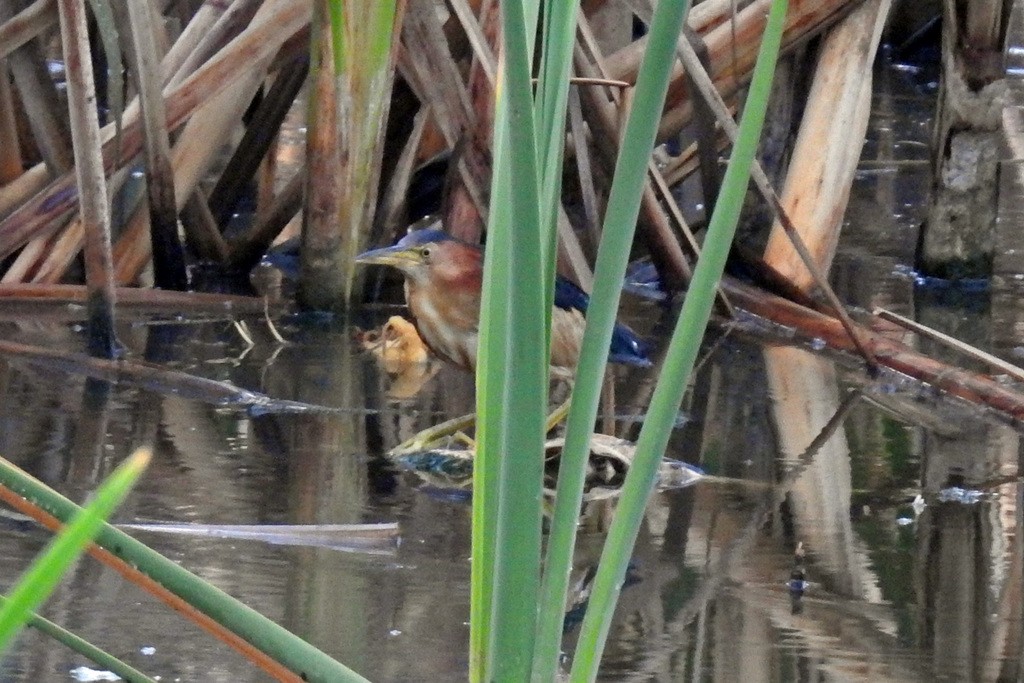Black-backed Bittern
A species of Small bitterns Scientific name : Ixobrychus dubius Genus : Small bitterns
Black-backed Bittern, A species of Small bitterns
Botanical name: Ixobrychus dubius
Genus: Small bitterns
Content
Description General Info
 Photo By deborod , used under CC-BY-NC-4.0 /Cropped and compressed from original
Photo By deborod , used under CC-BY-NC-4.0 /Cropped and compressed from original Description
This species measures from 25 to 36 cm (9.8 to 14.2 in), has a total weight of 60–120 g (2.1–4.2 oz), averaging 84 g (3.0 oz). This is a very small bittern and one of the smallest herons in the world. The adult male has largely black upperparts, including a black cap, while the underparts, as well as the neck, breast and the sides of the head, are rich chestnut. There are large buff patches on the shoulders, conspicuous in flight. The female is duller, brown and streaked on back and crown; immature birds are similar. The irides are yellow, the bill is yellow with a black culmen, and the feet and legs greenish-yellow. 
Nest Placement
Ground
Feeding Habits
Black-backed Bittern's diet primarily consists of aquatic invertebrates, including crustaceans and dragonfly larvae, as well as small vertebrates like fish and frogs. They employ a hunting strategy that combines patient waiting with active stalking to capture prey within bill's range.
Habitat
Black-backed Bittern is commonly found in dense wetland habitats comprising freshwater swamps and reedbeds with emergent vegetation like reeds, sedges, and inundated shrubs exceeding 1.5 meters in height. While they prefer freshwater environments, including still waters and occasional slow-moving rivers, they can also inhabit brackish and saline wetlands such as mangrove swamps, and Juncus-dominated salt marshes. Their geographical range includes various temperate to tropical regions, and they can be found in the dense vegetation at the edges of wetlands and occasionally in urban parks.
Dite type
Piscivorous
General Info
Feeding Habits
Bird food type
Behavior
Black-backed bitterns are solitary, secretive and seldom seen, mainly active at dusk or at night. They are skulkers of reed beds, walking in a crouched posture with head extended forward, crossing patches of open ground rapidly, stalking their prey at the water's edge. When alarmed they will assume the cryptic posture typical of many bitterns, standing still with the head and bill extended vertically upwards. Usually reluctant to fly, when flushed they will do so with retracted head and dangling legs, skimming low over the water and the wetland vegetation. 
Species Status
Black-backed bitterns are listed as Near Threatened nationally in Australia, and as Endangered in Victoria. The global population has been estimated to comprise about 5000 mature individuals, mainly within Australia, including a sub-population of more than 1000 individuals in south-western Western Australia. Threats include various ongoing wetland degradation factors such as salinisation, drainage and the diversion of water for irrigation, as well as the destruction of nesting habitat by inappropriate burning regimens. 
Scientific Classification
Phylum
Chordates Class
Birds Order
Pelicans and Relatives Family
Herons Genus
Small bitterns Species
Black-backed Bittern